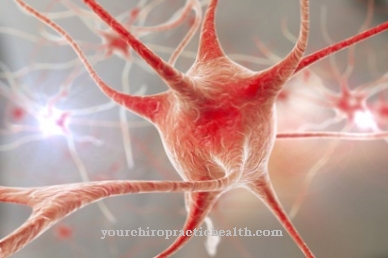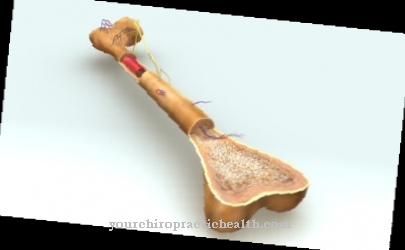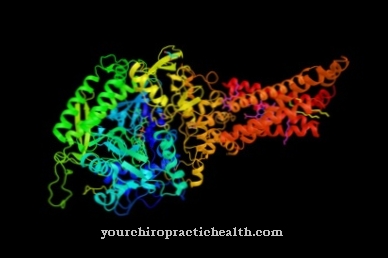The Vasomotor activity includes all movement processes in the arteries and arterioles. These movements correspond to either a contraction or a relaxation of the vascular muscles and cause a change in the lumen of the vessels. Patients with Raynaud's syndrome suffer from vasomotor spastic disorders.
What is the vasomotor system?

Arteries and arterioles carry blood to the individual organs. There is hemoglobin-bound oxygen in the blood, which is released depending on factors such as the pH value. The ateries and arterioles are responsible for the vital transport of oxygen to individual organs and tissues.
Active movement processes for blood transport take place in the vessels. These movement processes are known as vasomotor functions and regulate the amount of blood. Vasoconstriction is one of the vasomotor functions. This is a contraction of the muscles in the vessels. The vessel lumen becomes narrow and the blood flow decreases. The opposite process is vasodilation, in which the vascular muscles relax. The vessel lumens expand and the blood flow increases.
These processes are controlled by the autonomic nervous system. In addition to baroreceptors in the common carotid artery and the internal or external carotid artery for determining the elongation of the vessel wall, the vessels contain chemoreceptors for determining the partial pressure of oxygen and carbon dioxide. The afferent innervation of these receptors leads to the sympathetic nervous system, which initiates vasomotor processes and reacts with increased vasomotor activity by constricting noradrenaline.
Function & task
The vasomotor system includes all movements of the blood vessels. These movement processes are based on the one hand on spontaneous activity and on the other hand on humoral and neural influences. Mediators such as histamine and norepinephrine play a role in this.
The control of the vasomotor system is subject to the autonomic nervous system, especially the sympathetic nervous system. It has a vasoconstrictive and tonic effect on the blood vessels. In active vasodilation and vasoconstriction, the nerves and muscles of the vessels work together. Active vasodilation corresponds to a relaxation of the muscles. Active constriction is a contraction of the vascular muscles.
The passive forms of vasomotor activity depend on the volume of blood. Increased blood volume leads to passive vasodilation. A low volume, on the other hand, leads to passive vasoconstriction. The vasomotor system plays an increased role in arterial blood pressure.
The basic requirement for pressure control in the arteries and arterioles is the body's own ability to measure the pressure in the vessels. The pressure conditions in the aorta as well as the carotid arteries and other arteries in the chest and neck are measured by pressure-sensitive mechanoreceptors. These sensory cells of the skin's senses are the baroreceptors that register expansion of the vessel walls and pass on expansion changes to the autonomic nervous system.
Analogously, the oxygen content in the blood is measured by the chemoreceptors in the vessel walls. This measured information plays a role in regulating breathing. A mechanism for short-term arterial pressure regulation is, for example, the baroreceptor reflex. The sympathetic has a vasoconstrictive effect. This means that it takes care of the basal tone of the vessels. When high pressure is measured by an increased volume in the arterial wall, the baroreceptors reflexively send an inhibitory impulse to the sympathetic nervous system. If the arterial blood pressure is too low, on the other hand, they hardly send any inhibitory impulses. This irritates the sympathetic nervous system, so that the volume of blood ejected from the heart increases. Apart from that, it can induce vasoconstriction of the skin, kidneys and gastrointestinal tract.
Basically, relaxation of the smooth vascular muscles triggers vasodilation, as it is caused by visceromotor vegetative nerve fibers. Locally formed mediators such as acetylcholine or endothelin also stimulate the endothelial receptors and thus stimulate the formation of nitric oxide and prostacyclin, which contribute to vascular dilation. In contrast, messenger substances such as arginine-vasopressin, adrenaline and noradrenaline have a vasoconstrictive effect. The circulation is maintained by the vasomotor system. The organs and tissues receive sufficient blood and oxygen through the processes.
Illnesses & ailments
Vasomotor disorders are also known as vasomotor disorders and are mainly observed in connection with lesions of the vasomotor autonomic nerves. These lesions can affect both the vasoconstricting and the vasodilating nerves. The disorders are also associated with damage to the brain, elongated marrow, spinal cord, and peripheral nerves. Under certain circumstances, neuroses can also be related to vasomotor disorders.
In most cases, the vessels change pathologically with disorders of the vasomotor system. Accompanying symptoms, they can cause complaints such as hot flashes, headaches, sweating, circulatory instability or feelings of cold.
Vasomotor headache corresponds to a regulatory disorder that affects the vessels in the head and causes vegetative dystonia. The most common accompanying symptoms of such headaches are dizziness, palpitations and nausea as well as cold and damp hands and feet. One of the most common primary causes of vasomotor disorders is menopause.
Under certain circumstances, the disorders can also be due to Raynaud's syndrome. This clinical picture is caused by vasoconstrictions and vascular spasms, like attacks of ischemia with reduced blood flow, which primarily affect the arteries of the toes and fingers. In the further course, the vessel walls are damaged. The tunica intima thickens or a capillary aneurysm develops. Primary Raynaud's syndrome is believed to be a genetic predisposition to vasomotor disorders. Hormonal factors can be involved.
Secondary Raynaud's syndrome can occur in the context of collagenoses, rheumatoid arthritis, arteriosclerosis or cryoglobulinemia. The syndrome is just one of several diseases that promote spastic phenomena within the vasomotor system. Other diseases from this group are migraines and angina pectoris, which can also occur in combination with Raynaud's syndrome if the patient is at risk.













.jpg)

.jpg)
.jpg)











.jpg)